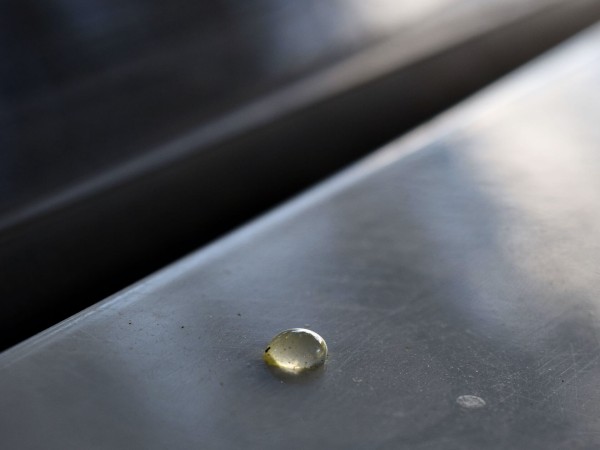Parking under a tree can be practical: You get some shade in summer and it keeps the interior temperature cooler. But there is often a nasty surprise attached when you return to your car... Tree resin all over the paintwork and roof. This troublesome muck is more than a visual problem as it can damage the paint, among other things. So what can help combat tree resin on your car? The advice section of verdeck.de tells you how you can remove sticky resin from your car and what household products can help you.
Contents
- Does tree resin damage paintwork?
- How can you remove tree resin from your car?
- What household products can help combat tree resin?
- Preventing resin patches on your car
- Summary: Acting quickly is key!
Does tree resin damage paintwork?
Modern car paints are well protected from external factors so, in general, tree resin shouldn’t cause any damage. Older cars however, especially classic cars, might suffer from residue on the paintwork. The golden rule is to remove tree resin as quickly as possible, while it is still fresh and soft so that the paint does not become discoloured underneath, which leaves visible patches even after removing the resin. The resin can act like a lens, damaging the material underneath when sunlight shines through it. Not to mention that fresh tree resin is easier to remove. It is rock hard once it has dried. Then it becomes harder work to remove and the process can cause further damage to the paintwork or convertible top.
How can you remove tree resin from your car?
Removing tree resin, whether fresh or dried, is not actually hard. Resin is fat-soluble, meaning it can easily be removed with a range of cleaning agents. Specialist tree resin removers are available, plus lubricating oil (like WD-40) can help combat this pesky muck. But don’t be too quick to leap to action: Some cleaning agents can leave marks on the surface underneath. It is therefore important to determine where the resin is. Then you can select the correct course of action.
Removing tree resin from your windscreen
If the resin is on the windows, you have got off lightly! Even dried resin can be removed without a trace since glass is much harder wearing than paint. Dried-on resin can be removed using a glass scraper or ice scraper. If the resin is fresh, specialist cleaners and lubricating oil will help clean up your car. Whether the resin is fresh or dry, though, always avoid using your windscreen wipers. They can spread the resin around the windscreen or the resin can stick to the blades, damaging the wipers themselves.
Removing dry resin from car paintwork
If the tree resin has already dried onto the car, it is trickier to remove from your paintwork. Normal soap or car shampoo won’t help at this stage. Instead, a specialist tree resin remover or lubricating oil is recommended. Always pay attention to the instructions on the packaging. Usually, the cleaner is applied to a cloth, which is then pressed onto the resin. After giving the cleaner a little time to sink in, it breaks up the resin so it can be removed. Larger patches will require several applications. Fresh resin can be removed in the same way except it doesn’t need the cleaner to soak in for as long.
Important: Never try to melt dried tree resin with a hot hairdryer! It will simply dry the resin faster, making it even harder. Plus, if the temperature is too high, you might damage your paintwork.
Removing tree resin from your convertible top
If your convertible has a soft top, the tree resin can cause severe damage. Especially if it has been left for an extended period. The fabric is much easier to damage than paintwork or glass. Resin must therefore be removed as quickly as possible. Fresh resin can be removed with warm soapy water and a cloth. Avoid applying too much pressure or rubbing too much. If the resin has been sitting a while, only a specialist cleaner will be able to help. Always ensure that your cleaner is suitable for use on soft tops. For example, lubricating oil cannot be used as it leaves grease marks on the fabric.
Specialist tree resin remover is one option that is suitable for use on convertible roofs. Freeze spray can work wonders, too. The spray cools and hardens the resin intensely enough to remove it. Whatever car care products you decide to use, the key is to do so sparingly and only where needed. Several applications are recommended, always rinsing the hood with clean water in between. When in doubt, convertible owners should always take their car to a professional to avoid damage to the convertible top. For future, it is also helpful to use a coating on the hood to provide additional protection from marks of any kind.
What household products can help combat tree resin?
Common household products can provide effective ‘first aid’ for cars affected by tree resin. The best way to remove resin is to use an oil. This could be cooking oil, baby oil, even margarine or butter. Even door de-icer or de-icer spray can be effective on this pesky substance. The alcohol in the de-icer dissolves the resin without damaging car paintwork. Methylated spirits and white spirit work on the same principle. Shaving foam and acetone can also help with cleaning. The key is to test the compatibility of the product with the material on your particular car and, after cleaning, to rinse the affected areas with warm water, a little soap and a cloth to remove any residue of the resin or the cleaning product.
Preventing resin patches on your car
In the ideal case scenario, you can avoid these tricky resin patches by sticking to the following rules: Of course, the first is simply not to park your car under a tree. However, depending on the spaces available and the time of year, sometimes this cannot be avoided. If you park your car under a tree for an extended period, you should consider using a cover. Specialist businesses offer “mobile garages”, canvas covers and fabric covers – all effective ways to protect your car from tree resin. A protector treatment adds a special protective layer to the paintwork, reducing the risk of paint damage. It also makes it harder for the resin to stick, making cleaning easier and reducing the likelihood of damage.
Summary: Acting quickly is key!
Tree resin is tough, unsightly and can damage your car. The paintwork and soft top are at most risk from this tricky substance. It is important to find the right parking space, but drivers don’t always have that much choice. You should therefore regularly inspect your car for resin patches so that you can act quickly if you find any. Fresh resin can be removed with soap and water but older patches may need some extra help. You can use specialist cleaner or household products. Whatever you chose, always be careful and take your time in the cleaning process to avoid resin damage.


